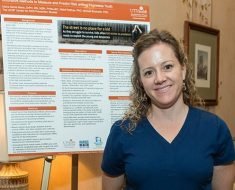
For families with deaf children, a cochlear implant can feel like a miracle: An electronic device weighing less than an ounce, seemingly capable of opening a world of sound.
But a new study by a University of Chicago medical anthropologist lays out the complications these implants also can cause, especially when they are used as cure-alls, rather than as part of a holistic treatment program featuring language-focused therapy
In a case study published in this month’s New England Journal of Medicine, Asst. Prof. Michele Friedner examines how a deaf child in India received a cochlear implant at five years old, only to have it break, leaving him without access to either spoken or signed language by age 12. The boy’s struggles, she said, highlight the need for medical professionals to better inform patients about technological interventions—and for them to recognize that living with disabilities is not only possible, but normal.
“I’m not arguing that cochlear implants are not a good thing,” said Friedner, a leading expert on deaf communities in India. “They just also have to be seen in context. We have to think about the complex dependencies and relationships they can create long-term.”
Friedner’s study focuses on a child named S., whose family lives five hours away from the Indian capital of Delhi. After S. was diagnosed as deaf at a year old, a physician told his family to get a “machine” to help him hear. After hearing aids failed to improve S.’s condition, that advice sent the family down a path that included a $10,000 cochlear implantation, plus more money for maintenance and repairs.
Because Indian Sign Language remains stigmatized even as its visibility increases, doctors never informed S.’s family that signing was a viable option to help their son learn language and attend school. The boy’s father earned less than $200 a month as a cloth seller, but he and other family members borrowed money for the cochlear implant. They had even considered selling their land, so invested they were in S’s success and in the idea of implantation as the only way for him to become “normal.”
However, the school in their village still declined to educate S. over the next five years, claiming it was too difficult to accommodate his needs. This prompted the family to move to Delhi, where the child continued to lag behind his peers. During their time in Delhi, they also had to purchase new batteries and cables for the implant. Eventually, the processor broke, requiring a $3,950 replacement the family could not afford.
Now 12 years old, S. mostly communicates via informal gestures. His family remains reluctant to pursue sign language education, seeing it as a sign of failure after having invested so much time and money into their son’s still-broken cochlear implant.
S. is unfortunately not unique, Friedner said. Too often, surgeons push families toward cochlear implants at the expense of other options. Because only a small handful of companies make implants, patients also become dependent on a manufacturer for batteries, accessories and replacement parts. If the devices fail, Friedner added, the lack of alternatives can create children and adults “who are neither deaf nor hearing,” often unable to navigate the world through any type of formal language.
Government officials in India have poured millions into promoting and sponsoring the use of cochlear implants—viewing it as an expensive, one-time fix. But the central government only offers two years of support for the devices, leaving many families in a financial lurch if problems occur.
Because many surgeons see successful cochlear implantation as a marker of prestige, they often pursue surgery without learning about legislation and policies that exist to support disabled people. Very few work in close collaboration with allied health and rehabilitation professionals and speech therapists, who usually spend much more time with patients.
Had S. lived in a culture that allowed for multiple understandings of “normal,” he could have been given the chance to learn sign language in conjunction with his cochlear implant. Perhaps, Friedner argued, the family might not have chosen surgery at all. Challenging conventional attitudes toward disabled people, she said, could go a long way toward fixing the problem—both within India and in similar situations across the globe.
Source: Read Full Article





